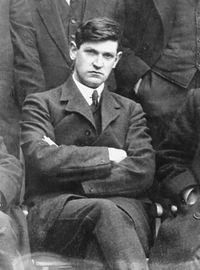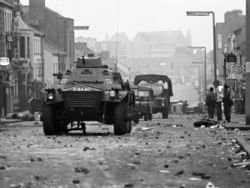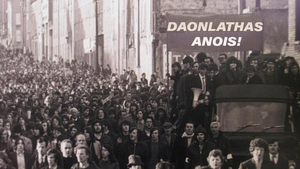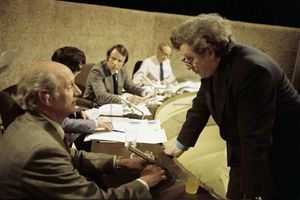Black Revolution
| Black Revolution | ||||
|---|---|---|---|---|
| Part of Gjorkan Resistance | ||||
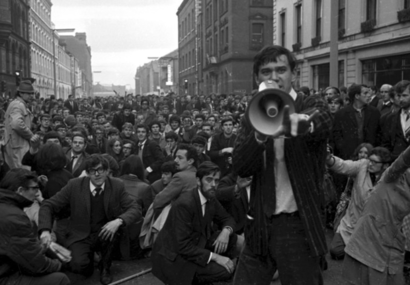 A protest in Gjorka City following Tannerburg's announcement | ||||
| Date | September 3, 1971 - November 11, 1972 | |||
| Location | ||||
| Caused by |
| |||
| Goals |
| |||
| Methods | Protests, Riots, Demonstrations | |||
| Resulted in | Restoration of Gjorkan Democracy | |||
| Parties to the civil conflict | ||||
| ||||
| Lead figures | ||||
| Number | ||||
| ||||
| Casualties and losses | ||||
| ||||
The Black Revolution were a series of demonstrations in Gjorka that occurred as a result of the 1971 Gjorkan coup d'état, and Austin Tannerburg's announcement of the return of Gjorkan democracy. Following this announcement, protesters around Gjorka flooded the streets in celebration. Military units, which had been mobilizing in response to Tannerburg's coup to perform a counter-coup, faced mass desertions and were forced to disband. Tannerbug initially attempted to suppress the protests (as his announcement was only to disrupt the counter-coup); However, the sheer magnitude of protestors forced Tannerburg to ultimately concede and allow for a transition period to take place. On November 11, 1972 the Third Gjorkan Republic was declared, and democracy was restored to Gjorka.
Background
Gjorka had been ruled by a dictatorship for over a hundred years. From 1850 to 1918, the First Gjorkan Republic ruled as an oligarchical dictatorship. In 1911, the Blue Revolution occurred where pro-democracy protestors (primarily marking themselves with blue flags) attempted to overthrow the government. They succeeded in securing Gjorka City, but the High Court escaped leading to the Second Gjorkan Civil War. The war initially began as a fight between the loyalist government and a general pro-democracy coalition. However in 1917, the Revolutionary government was overthrow and replaced by a military government leading to the creation of a rival socialist government. The Revolutionary government emerged victorious in the war, and established the Second Gjorkan Republic, another dictatorship.
Despite the surrender of the loyalist and socialist governments, several groups refused to give up the fight. The Gjorkan Republican Army (APG) made up of loyalists, and the Army of the Proletariat (ANP) made up of socialists were the primary paramilitaries continuing the fight. This early period of what eventually became know as the Gjorkan Resistance was called the War Against Socialism. However, in 1923 when President Éamon de Valera announced elections would be suspended indefinitely the resistance expanded in a broader anti-government movement. More paramilitary groups entered the fight including the right wing Golden Dawn, the hardline communist Front for the Liberation of Gjorka (AHSG), the Democratic Coalition of Gjorka (CDG), and the Gjorkan Liberation Army (AFG) which was made up of former leftwing members of the APG who broke away.
The resistance lasted for 53 years from 1919 to 1972, and saw tremendous death and destruction. The Military Government cracked down brutally on revolutionary activity, and suppressed democratic ideas. Some historians estimate as many as 200,000 Gjorkans were killed over the decades in anti-government massacres. Some reform was offered during the rule of Eli Mannion who drew back much of the near total police state created by his predecessors. However, many of Mannion's reforms were undone when he was ousted by Caelan MacRory. This crackdown on free activities reignited the resistance movement, particularly among young adults. The APG grew to become Gjorka's largest anti-resistance group led by Samuel MacMorrow who choose to focus more on civilian demonstrations than military actions as leader of the APG. In 1971, MacRory died leading to the formation of a transition government who planned to choose MacRory's successor. At the same time, protests and anti-governemnt actions were becoming more common place, as public disaffection with the dictatorship reached a critical point.
1971 Coup
By the time of Caelan MacRory's death in 1972, the military had grown incredibly corrupt. Generals often ignored orders from superiors, and worked with local mobsters to sell arms. This led to a warlord system where powerful generals would control areas of the country, and could act with near impunity. The transition council formed in the wake of MacRory's death was made up of these warlords. Most of the council had no intention of choosing a successor, instead planning to keep the transition in power indefinitely and increase their power. This move was incredibly unpopular with some of the office corps, particularly Major Capitan Austin Tannerburg who commanded the 2nd Armored Battalion and 4th Motorized army battalions. Tannerburg had served directly under MacRory and thus was not a participant in much of the corruption within the army. Given the lack of superiors, Tannerburg was able to move his forces with impunity. Using this to his advantage, Tannerburg positioned his forces around Gjorka City where the transition council was meeting.
On August 27, 1971, Tannerburg launched a coup d'état against the transition council. The coup was successful, and all of the warlords were arrested. Tannerburg declared himself President of Gjorka and Supreme Marshal of the Armed Forces. With the majority of Gjorka's senior military leadership arrested, chaos spread throughout the armed forces. Several leaders throughout the army did not support Tannerburg's coup and began moving against him. By August 31, commanders Séan O'Lee, Patrick O'Griffy and Danny Lucas had already openly declared they did not recognize Tannerburg as President and began moving their military forces against him. Other military leaders stopped responding to Tannerburg's messages as they considered wether to support him or move against him. By September 2, Tannerburg learned the three commanders had created an alliance to overthrow him and secured the support of much of Gjorka's military. Fearing a counter-coup, Tannerburg attempted to win over the support of the people. On September 3 1971, Tannerburg announced in a live address to the nation his intention to restore Gjorkan Democracy. Tannerburg did not intend to keep his promise, but rather use the public support of his administration to win over the remainder of the military and disrupt the counter-coup.
Revolution
Immediately following Tannerburg's announcement of the return of Gjorkan democracy was the largest celebrations in Gjorkan history. It is an estimated on September 3, 1971, the day of Tannerburg's announcement, nearly 5,000,000 Gjorkans across the country were celebrating in the streets. By September 4, that number had jumped to an estimated 20,000,000 Gjorkans, 40% of the population at the time. The counter-coup against Tannerburg completely fell apart. Partly because the simple mass of people in the streets was far too large to conduct military operations, and secondly because soldiers were deserting en masse. Tannerburg declared a nation wide curfew, but was unable to curtail the protests. The military government in Nomakoa surrendered to protestors outside city hall and a government sponsored by the AFG was instituted. The government in Éire declared martial law and violently suppressed protests including the Templeby Square Massacre which saw 10 protestors killed.
The APG, CDG, AFG, and ANP all declared an immediate ceasefire in the wake of Tannerburg's announcement. Protestors from the APG were able to gain control of the National Radio Service in Gjorka City and Samuel MacMorrow gave a national radio addresse declaring that Tannerburg should immediately resign and hand control over to the APG. The AFG government in Nomakoa declared a de-militarized zone within the Greater Nomakoa region, and ordered all military units to immediately leave or disband. The right-wing paramilitaries Golden Dawn and the Valkist Front and the left-wing paramilitary Front for the Liberation of Gjorka (AHSG) all declared they had no intention to stop fighting as none of the groups believed in implanting democracy.
Celebrations quickly turned into protests and riots as Tannerburg continued to hold on to power. He ordered all military units in the country to regroup at the capital. Many units ignored the order, and any units that attempted to carry out the order were swarmed by mobs of people harassing the military. By September 14, the cities of Nomakoa, Elkton, and Louth had all surrender to protestors and begun setting up civilian governments. Within Gjorka City, a majority of the city was under the control by the APG or protestors, with only the central government buildings still controlled by the military. Tannerburg finally folded and on September 15 he ordered all units across the country to stand down. The triumvirate counter-coup of Séan O'Lee, Patrick O'Griffy and Danny Lucas held out until September 17, but then too also ordered their units to stand down. Tannerburg began negotiating with rebel leaders, and created the National Democracy Transition Committee with representatives from each of Gjorka's primary paramilitaries.
Protests continued on in the country during the transition process. Teddy Haughey, leader of the Front for the Liberation of Gjorka (AHSG), led a 10,000 person march on Gjorka City for the AHSG not being included initially in the Transition Committee. Additionally when the constitution of the new republic was announced, including the banning of Khorosiyans from voting and non-Gjorkans from running for office sparked protests across the country namely in Roscommon, where most of Gjorka's Khorosiyan community lies, and Dontalamh which has a significant minority population.
Transition of Power
The Transition Committee first was gathered on October 1, 1971. It was initially composed of Tannerburg, and representatives from the APG, who were in majority control of Gjorka City at the time. Samuel MacMorrow led the APG delegation and heavily pushed for the inclusion of other groups, but Tannerburg refused to include groups he deemed "socialist". This move was heavily protested by other groups with the AFG and ANP threatening to re-establish the People's Republic of Gjorka in response. MacMorrow eventually convinced Tannerburg to include other groups in the Committee by threatening to pull out entirely. The second edition of the Committee included the APG, CDG, AFG, and ANP with notable representatives being MacMorrow, Dennis Fitzpatrick, Colm O'Coffey, and Aaron Woodrow. Tannerburg's influence over the committee gradually waned over time and he eventually stopped attending all together.
The Committee intensely debated over various issues with the framework of the democratic Gjorkan government and the disarmament and peace process being the two most fierce. The APG and CDG desired a presidential republic with a strong executive and a bicameral legislature, while the AFG and ANP proposed a semi-presidential republic with a strong unicameral parliament. As well, the issue of other paramilitaries who refused to participate in a democracy namely the AHSG, Golden Dawn, and the Valkist Front all of whom had not declared a ceasefire. The groups all demanded key concessions from the Committee in order to agree to de-militarize and democratize. The AHSG demanded the Gjorkan military be heavily scaled down, military leadership be prosecuted for their crimes, and for Gjorka to re-ope the border with Ajakanistan and Zloveshchiy. Golden Dawn and the Valkist front demanded for Khoroshiyans not be allowed to vote, and for non-gjorkans to be unable to run for office, and for the first legislature of the new republic to not be elected but have the paramilitary groups be given representatives proportionally. Despite initially pushing back against most of the demands, the Committee eventually folded and granted most of the radical groups demands.
On July 17, 1972 the Committee announced a finalized plan for the new Gjorkan Republic with a President and a unicameral legislature, and that the new republic would be declared on November 11, 1972. The presidential election would occur November 11th as well, but the first National Assembly of the new republic would not be elected, instead representatives given proportionally to each of Gjorka's paramilitaries. Samuel MacMorrow was elected first President of Gjorka running under Gjorka United.
Legacy
The Black Revolution brought Democracy to Gjorka for the first time in nearly a 122 years. The revolution generally has a very positive view by most Gjorkans, with the anniversary of the revolution's end on November 11 being a national holiday. The New Democratic government gradually brought economic prosperity with the standard of living in Gjorka raising greatly over the next decades.
Gallery
Protestors in Nomakoa, sign reads "Democracy Now!"
A protest in Gjorka City following Tannerburg's announcement
See Also
- Blue Revolution, Gjorka's first "color revolutions"
- Pink Revolution, Gjorka's third "color revolution"
- Color revolution
